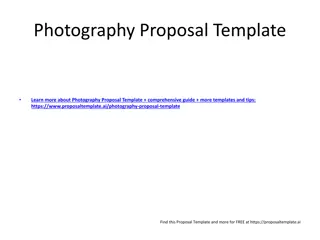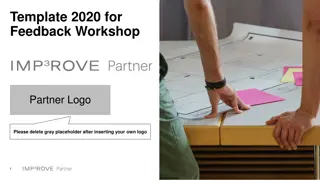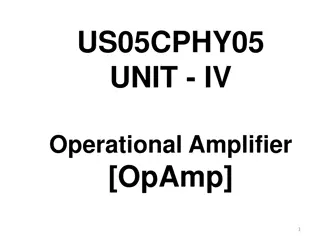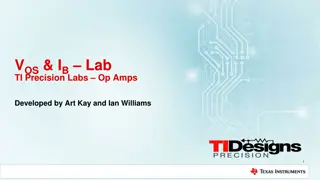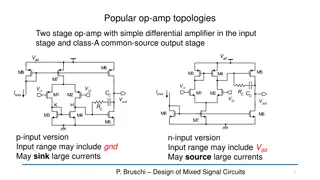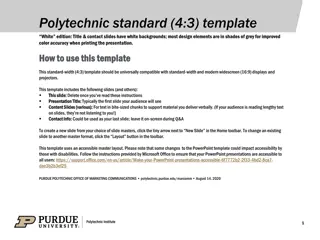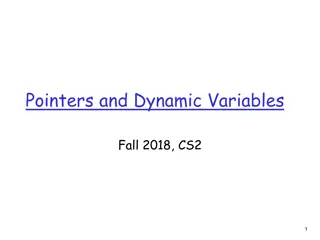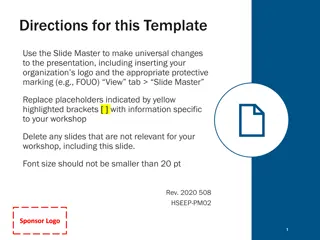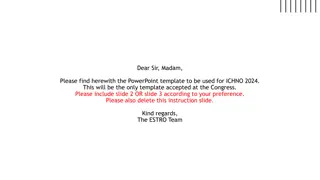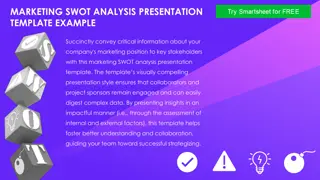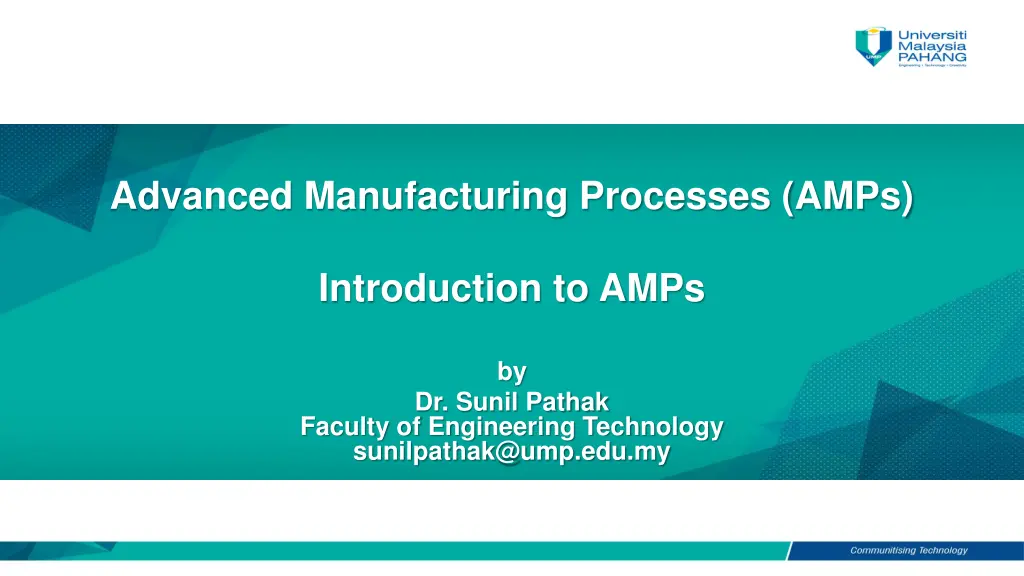
Understanding Advanced Manufacturing Processes and Machining Techniques
Explore the world of Advanced Manufacturing Processes (AMPs) and learn about the need for these processes, different materials used in engineering applications, and the limitations of conventional machining methods. Discover why advanced machining processes are essential for complex shapes, high precision, and superior surface finish in manufacturing.
Download Presentation

Please find below an Image/Link to download the presentation.
The content on the website is provided AS IS for your information and personal use only. It may not be sold, licensed, or shared on other websites without obtaining consent from the author. If you encounter any issues during the download, it is possible that the publisher has removed the file from their server.
You are allowed to download the files provided on this website for personal or commercial use, subject to the condition that they are used lawfully. All files are the property of their respective owners.
The content on the website is provided AS IS for your information and personal use only. It may not be sold, licensed, or shared on other websites without obtaining consent from the author.
E N D
Presentation Transcript
Advanced Manufacturing Processes (AMPs) Introduction to AMPs by Dr. Sunil Pathak Faculty of Engineering Technology sunilpathak@ump.edu.my
Chapter Description Aims To provide and insight on advanced manufacturing processes To provide details on why we need AMP and its characteristics Expected Outcomes Learner will be able to know about AMPs Learner will be able to identify role of AMPs in todays sceneries Other related Information Student must have some basic idea of conventional manufacturing and machining Student must have some fundamentals on materials References Prof N K Jain (IIT Indore, Lecture Notes) Prof. V K Jain (IIT Kanpur, Lecture Notes)
Materials Used In Engineering Applications Plastics and Composites Ceramics Metal and its Alloys Engineering Materials Having Much Superior Properties Getting More Popularity Definite Advantages Over Others HOW TO MACHINE THEM ? Ultra High Strength, Hardness Very High Temperature Resistance Difficult To Machine By SOLUTION Conventional Machining Methods Advanced Manufacturing/Machining Processes
Need of Advanced Manufacturing/Machining Processes Limitations of conventional machining methods (workpiece hardness, surface roughness, 3-d parts and complex geometries) Increased Workpiece Hardness Decreased Economic Cutting Speed Lower Productivity Rapid Improvements In The Properties Of Materials (WorkpieceHardness, Strength, Etc.) Metals & Non Metals : Stainless Steel , High Strength Temperature Resistant(hsrt) Super Alloys: Stellite, Incoloys Etc. Tool Material Hardness >> Workpiece Hardness Requires Much Superior Quality Of ToolMaterials
Need Of Advanced Manufacturing/ Machining Processes ?? Product Requirements Complex Shapes High Production Rate While Processing Difficult To- Machine Materials Machining In Inaccessible Areas Low Tolerances (Say, 10 m) Low Cost Of Production Precision And Ultra precision Machining(Nano-meter Machining) Better Surface Integrity (No Surface Defects, Etc.) Requires Material Removal In The Form Of Atoms And / Or Molecules High Surface Finish (Nano Level Ra Value =>Nm) Miniaturization Of Products (Examples: Landline Phone & Mobile, Old Computers & Lap Top, Etc.) ADVANCED MACHINING PROCESSES(Amps) High Mrr
Behaviour and Manufacturing Properties of EngineeringMaterials Structure of Material Physical and Chemical Properties Property Modification Mechanical Properties Strength Ductility Elasticity Stiffness Hardness Toughness Fatigue Creep Resistance to Wear, Corrosion, Oxidation HotHardness andStrength Heat Treatment Annealing Tempering Normalizing Hardening Alloying Reinforcement s Composites Laminations Fillers Surface Treatment MeltingPoint Density SpecificHeat Thermal Conductivity Thermal Expansion Electrical Conductivity Magnetic Properties Oxidation Corrosion Atomic Bond: Metallic, Ionic,Covalent Crystalline Amorphous or Non-Crystalline PartlyCrystalline Polymer Chains
[1] CLASSIFICATION OF VARIOUS MANUFACTURINGPROCESSES Basic Nature Advanced or Unconventional Processes Rapid Prototyping Processes [After1990] LiquidBased Traditional or Conventional Processes Casting and MoldingProcesses Primary Forming Processes Multiple-UseMold Casting Powder Based Single-Useor Expendable MoldCasting Multiple-use Pattern SolidBased [Additive Or Accretion: Create Shape From Molten, Gaseous, or Solid Particles] Single-use Pattern PermanentMold Casting: Slush casting, Corthias Casting Low- pressure Vacuum Casting Die Casting, Squeeze Casting, Centrifugal Casting, Semicentrifugal Casting CentrifugingCasting, ContinuousCasting, ElectromagneticOr LevitationCasting Processes [LateNineteenth SLS, BPM, TDP, MJS, DSPC, etc. SLA, SLT, SGC, SOUP , SCS,etc. FDM, LOM, MJM, SAHP,etc. Investment Casting, For Fabrication of Polymers: Thermoforming, Extrusion, Blow, Compression, Injection, Reaction Injection, Transfer, Cold, Rotational, & Foam Molding,Calendering,Spinning,Dipping, etc. For Fabrication of Ceramics: Blow Molding, Dry Pressing, Isostatic Pressing, FormingTechniques For Fabrication of Composites: Pultrusion, Vacuum-bag and Pressure-bag transfer Molding, Spray Molding, Sheet Stamping, Braiding,3D- Knitting&Weaving, SandCasting, Plaster Mold Casting, CeramicMold Casting, Rubber Mold Casting, GraphiteMold Casting, ShellMolding, Powder Metallurgy Century] Full-mold andLost- Foam Casting Slip Casting, Plastic Fiber Filament Reinforced Winding, Molding, Resin-
[1] CLASSIFICATION OF VARIOUS MANUFACTURINGPROCESSES (Cont) Basic Nature Deforming Processes Advancedor Unconventional Processes Advanced Metal Forming Processes High Energy Rate Forming (HERF) Processes: Electromagnetic Forming, Explosive Forming, and Electro-hydraulic Forming. LaserBending, 3d-laserForming, Hot Isostatic Pressing(HIP) Traditionalor Conventional Processes Metal FormingProcesses Hot- working Rolling, Forging, Extrusion, Hot- drawing, Piercing Cold-workingProcesses Squeezing: Cold Rolling, Cold Forging , Cold Extrusion, Swaging, Sizing, Riveting, Staking, Coining, Hubbing,and ThreadRolling. Bending: Angle Bending, Roll Draw and Compression forming, Seaming, Straightening. Shearing: Slitting, Blanking, Lancing, Perforating, Shaving, Trimming,Cutoff,and Dinking. Drawing: Spinning, Embossing, StretchForming,and Ironing Sheet-metal Forming Operations [Formative: Shapes The Material Solid Using Property Of Plasticity.] Peening, Burnishing, In State Bending, Bending, Roll- Flanging, and For Sheet Metal Components: Electroforming, Plasma Spray Forming Piercing, Notching, Nibbling,
[1] CLASSIFICATION OF VARIOUS MANUFACTURING(Continued) Basic Nature Traditional or Conventional Processes Advanced/Unconventional Processes Material Removal Processes Conventional Machining Processes [19th Century Onwards] Axi-symmetric Parts AMPs [After 1945] Prismatic Parts Electro- chemical General Mechanical Chemical Thermal Subtractive : Shapethe Product by Removing the Excess Material] Turning, Facing, TaperTurning, Milling, Shaping, Planning, etc. Sawing, Broaching, Hobbing, USM, AJM, WJM, CHM, PCM, TCM ECM EDM EBM LBM Threading, Grinding, AWJM, IBM Drilling, Boring, Honing, IJM, PAM Reaming,etc. Lapping, etc. AFM, MAF, MRF
[1] CLASSIFICATION OF VARIOUS MANUFACTURING(Continued) JoiningProcesses Joining Or Consolidation Or Fabrication Processes Advanced Welding Techniques: EBW, LBW , USW Welding Plastics (only Thermoplastics) :USW, LBW, Friction/spin Welding VibrationWelding Friction welding Hot-platewelding Hot-gas welding Implant welding Infrared welding Micro-wave welding MechanicalBonding Tempor - ary or permanent Thread joints Stitches, Staples, Shrink-fits, AtomicBonding Liquid state orFusion Welding Electrical Arc welding: Using Consumable Electrode SMAW , GMAW , FCAW , SAW; Those using Non- consumable Electrode: GTAW , PAW , SW. Resistance welding: RSW , RSEW , RPW. Permanent Solid state welding Friction, Forge, Diffusion welding, Solid/ Liquid state Brazing, Soldering, and Adhesive bonding semi- Chemical Gas welding: OAW , and PGW, Thermit welding Rivets, of [For assembling the various component s of a product] for Cold Welding: Pressure, Explosive, Ultrasonic Welding stir Induction welding
[1] CLASSIFICATION OF VARIOUS MANUFACTURING(Continued) Basic Nature Heat Treatment or Property Enhancing Processes Advanced or Traditional or Conventional Processes Unconventional Processes Laser Beam Hardening and Electron BeamHardening SURFACE Heating) Processes: Flame Hardening, Induction Hardening HARDENING (ie Selective and Bulk CASE HARDENING (ie Surface Altering) Processes: Carburizing (pack, gas, and liquid type), Nitriding, Carbonitriding. Chemistry Additional Depositing: Carburizing, Ion Plating, and Ion Implantation Layer Ionitriding, Ion HARDENING TECHNIQUES Cyaniding or [To the properties.] modify bulk CRACK REDUCTION TECHNIQUES: Austempering, Martempering Marquenching / DUCTILITY, TOUGHNESS, changing processes: Annealing (Full and Process type), Normalizing, Tempering, Spheroidizing. and MACHINABILITY STRENGTHENING processes: Solid Solution Strengthening, Grain Size Refinement, Strain Hardening, Precipitation or Age Hardening, Dispersion Hardening,and PhaseTransformation Hardening
[1] CLASSIFICATION OF VARIOUS MANUFACTURING (Continued) Advanced or Unconven tional Processes For burr Removal: USM, AJM, WJM, AWJM, AFM, ECDE Basic Nature Traditional or Conventional Processes BURR REOMVAL: Grinding, Chamfering, Filing, Centrifugal and Spindle Finishing, Thermal- energy Deburring, Power Sanding, Power Brushing, and Mechanical Cleaning describedbelow. Processes as CHM, MECHANICAL CLEANING Cleaning, Barrel Finishing Or Tumbling, Vibratory Finishing, Belt Sanding, Wire Brushing, Buffing, Electro-polishing. CHEMICAL CLEANING: Vapor Degreasing, UltrasonicCleaning. and FINISHING: Abrasive Finishing And Surface Treatment Processes Acid Pickling, Alkaline, Solvent, And COATING (Liquid/Gas Deposition): Painting, Coating, Hot Dip Coating, Electro-plating, Anodizing, Electroless or AutocatalyticPlating, Mechanical Plating,Porcelain Enameling. Chemical Conversion [To modify surface properties.] the COATING TECHNIQUES CLADDING (Solid deposition) Physical Vapor Vacuum Metallizing, Sputtering, Ion Plating Chemical Vapor Deposition (CVD) Deposition (PVD): VAPORIZED METAL COATING
Types of AMPs Basic AMPs: 15 (8 Mechanical + 1 Electrochemical + 1 Chemical + 5 Thermal) Derived AMP: Modification of Basic AMP to Meet SpecificObjectives Electro Stream Drilling(ESD) Shaped Tube Electro Machining (STEM) Electrolytic Jet Drilling(EJD) Photo Chemical Machining(PCM) Wire Electro Discharge Machining(WEDM) Centrifugal Force Assisted Abrasive Flow Machining(CFA-AFM) Derived AMPs fromECM Derived AMP fromCHM Derived AMP fromEDM Derived AMP fromAFM Derived Version of HMP have also ReportedTW-ECSM Hybrid Machining Processes (HMPs)
Hybrid Machining Processes (HMPs) [1] Concept of HMP Combining Either Two or More than TwoAMPs or AMP + Conventional MachiningProcess [2] When to Conceptualize and Develop an HMP ? To Simultaneously Exploit the Potentials and Capabilities of the Constituent Processes; and /or To Minimize the Adverse Effects Induced When a Constituent Process is Used Independently Generally, Development of an HMP is either Material or Shape Application Specific
HMPs are Gaining ConsiderableAttraction Meet Some of the Ultraprecision Machining Requirements Meet High Productivity Requirements for the Components Made of Advanced DTMMaterials Meet the Challenging Stringent Design Requirements Meet Extreme Surface Quality and Tolerance Requirement Types of HMPs [Can be Classified Into Two Major Categories (Kozak & Rajurkar, 2001)] Processes in which Constituent Involved in MaterialRemoval; Processes are Directly Processes in which only ONE of the Participating Material while others Only Machining in a PositiveManner Processes Directly Removes the ASSIST in Removal By Changing the Conditions of Most of the HMPs are in their Inception and Development Phase Sustained Research is Required to Transform HMPs into a Matured Manufacturing Technology and forTheir Successful Commercialization and IndustrialApplications
Combining EnergySources Conventional Machining + ElectrochemicalAMP Electrochemical+ Mechanical andAbrasion Electrochemical+ Mechanical andAbrasion Electrochemical+ Mechanical andAbrasion Conventional Machining + ThermalAMP Mechanical+ Thermal Abrasion Mechanical+ Thermal Abrasion Mechanical+ Thermal Abrasion Mechanical+ Thermal Mechanical+ Thermal Chemical+ Thermal Heating Conventional Machining + MechanicalAMP Mechanical + Ultrasonic Vibration Mechanical + Ultrasonic Vibration Mechanismof MaterialRemoval Transfer Media Process Tool Electrochemical Dissolution ECH Abrasive Sticks Electrolyte Electrochemical Dissolution ECG AbrasiveWheel Electrolyte Electrochemical Dissolution Metal Bonded AbrasiveWheel ECAG Electrolyte Examples of HMPs [Conventional Machining + AMP] Melting, Evaporation and LooseAbrasive Particles MetalBonded AbrasiveWheel Diamondwheel AEDM Dielectric Melting, Evaporation and EDAG Dielectric Melting, Evaporation and EDDG Dielectric LAT Shearing andHeating TurningTool Air PAT Shearing andHeating TurningTool Air Chemical Dissolution and LAE Mask Etchant Sonotrode having DiamondAbrasives TurningTool RUM Abrasion Coolant UAT Shearing Air
Combining EnergySources Mechanismof MaterialRemoval Electrochemical +Thermal Meltingand/Or Evaporation Transfer Media Process Tool Electrochemical+ Thermal ECSMor Electrode Electrolyte ECAM Electrochemical+ Thermal Electrochemical Dissolution and Heating Electrochemical + Mechanical Electrochemical Dissolution Electrochemical Dissolution +Abrasion Mechanical +Thermal Melting and Evaporation LAECM Electrode Electrolyte Examples of HMPs [Two or More AMPs] Electrochemical+ Ultrasonic Vibration Electrochemical+ Mechanical USECM Sonotrode Electrolyte ECMAF Abrasives Electrolyte Thermal + Ultrasonic Vibration Thermal + Ultrasonic Vibration USEDM Sonotrode Dielectric USLBM Melting and Evaporation LaserBeam Air Two MechanicalAMPs Shearing More than TwoAMPs Electrochemical,Melting and MechanicalRupture MRAFF Two MechanicalAMPs Abrasives MRFluid RotatingMetal Brush Electrochemical+ Mechanical + Thermal WaterGlass Solution In Water BEDMM
Typical Examples of Parts Developed by AMPs MALE FEMALE PRECISION WIRE EDM Figure:1 Typical parts made by electrochemical machining. (a) Turbine blade made of nickel alloy of 360 HB. Note the shape of the electrode on the right. (b) Thin slots on a 4340-steel roller-bearing cage. (c) Integral airfoils on a compressor disk. Design Made using 3D Printing
Important Characteristics of AMPs Process performance Workpiece hardness. Toughness, ductility, brittleness etc. is independent of properties Material such as Process Performance highly depends upon the thermal, electrical, magnetic and chemical properties of the workpiece material Process different source Mechanical, Thermal, Electrical Chemical in its direct form utilizes types energy Usually AMPs Possesses lower material removal rate as compared to conventional processes but in turns AMPs provide high quality parts Initial investment cost of setting an AMP is high due to costly machine tools and high operating costs of i.e. and
Dr Sunil Pathak,PhD - IIT Indore (MP) India Senior Lecturer Faculty of Engineering Technology University Malaysia Pahang, Kuantan Malaysia https://www.researchgate.net/profile/Sunil_Pathak4 https://scholar.google.co.in/citations?user=9i_j3sMAAAAJ&hl=en






